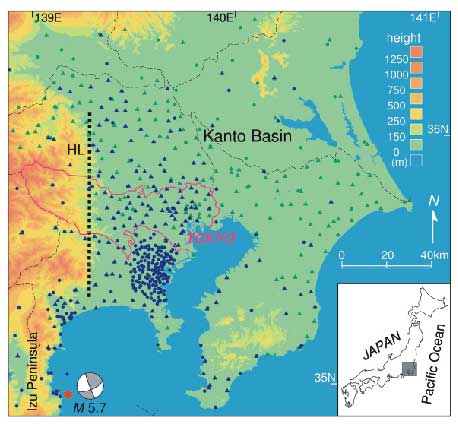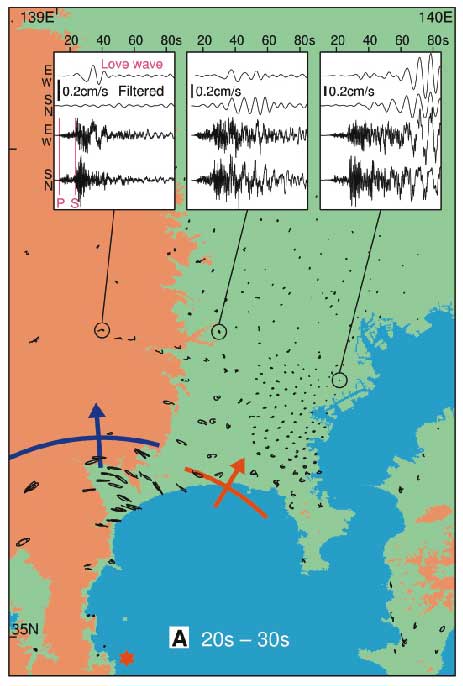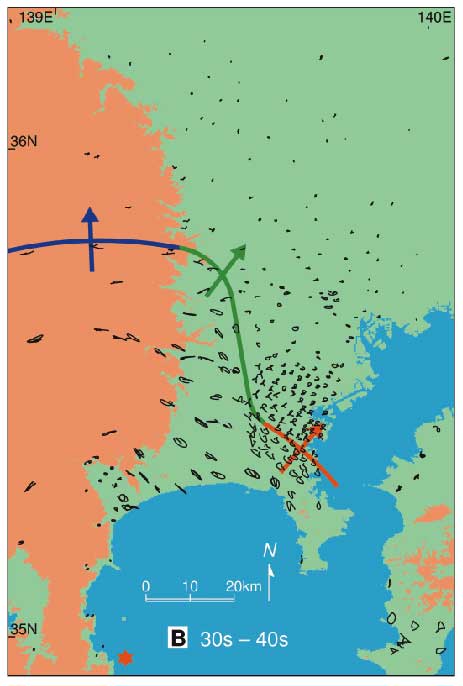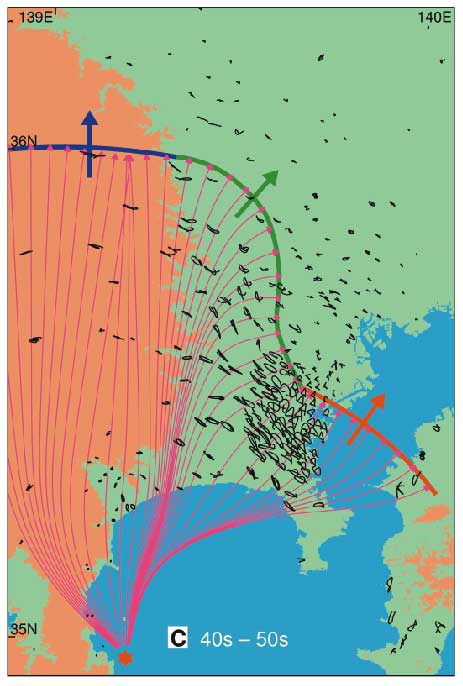
Fig.1. Topography of the Kanto basin and the distribution of about
600 strong motion
stations (Koketsu and Kikuchi, Copyright 2000 by Science).
Since seismic ground motion propagates from an earthquake through
subsurface structures, its
propagation should be complex in a complex subsurface structure. The
large-scale Kanto basin has
such complex structures that firm basement is exposed in the west and
thick sediments are distributed
to the Tokyo bay.
Several institutions including ERI have installed more than 600 strong
motion instruments in the
basin and its surroundings, recently (Fig. 1). An M5.7 earthquake at
a depth of 3km off the Izu peninsula
was observed by 384 out of them in May, 1998. Such a shallow earthquake
often generates long-period
surface Love waves, and these waves are seen in the Kanto basin with
periods of about 8s. The 384
observations enabled us to visualize the propagation of the ground
motion associated with these Love
waves.
To emphasize these waves we first converted the records to velocity
seismograms and applied a
low-pass filter with a period of 5s (Fig. 2A). Then we plotted the
trajectories of ground motion in the
horizontal plane for 10s intervals after the earthqauke on a map (Fig.
2A-D). The Love wave generates
ground motion parallel to its wavefront (perpendicular to its ray),
and so the trajectories can help us
identify the wavefront and ray. We normalized each trajectory to the
maximum amplitude for the
recording duration, to make small ground motions in the west visible.
We identified wavefronts by noting abrupt changes in the amplitude
and trajectory. The wavefront to
the west travels with a speed of 3.5 - 4 km/s, while that in the center
of the basin propagates as slow
as 1.0 km/s (Fig. 2 A→B→C→D). The difference between the speeds
causes a discontinuity between
the wavefronts, and a part of the Love wave in the west is refracted
into the basin in order to heal the
wavefront discontinuity (Fig. 2B-C). The process is analogous to the
generation of a head wave at an
interface. The refracted surface wave is dominant around the basin
edge and appears to propagate from
there rather than from the epicenter.
Numerical simulations and localized array analyses suggest the presence
of such surface waves which
do not come directly from the epicenter, but here it is verified by
actual records for the first time. The
physical mechanism of their generation is also interpreted as refraction
to compensate for a wavefront
discontinuity.
To confirm the above ground motion pattern, ray tracing has been carried
out for the Love waves.
The S-wave velocities are estimated from the results of geophysical
explorations, and horizontally
layered models are retrieved at grid points. The phase velocities of
the fundamental mode of the Love
wave are then calculated at a period of 8s using the local-mode approximation.
Rays are traced in their
distribution to 40s (Fig. 2C). The wavefronts connecting the tips of
the rays agree well with the
observed wavefronts.

Fig.1. Topography of the Kanto basin and the distribution of about
600 strong motion
stations (Koketsu and Kikuchi, Copyright 2000 by Science).
To emphasize these waves we first converted the records to velocity
seismograms and applied a
low-pass filter with a period of 5s (Fig. 2A). Then we plotted the
trajectories of ground motion in the
horizontal plane for 10s intervals after the earthqauke on a map (Fig.
2A-D). The Love wave generates
ground motion parallel to its wavefront (perpendicular to its ray),
and so the trajectories can help us
identify the wavefront and ray. We normalized each trajectory to the
maximum amplitude for the
recording duration, to make small ground motions in the west visible.
We identified wavefronts by noting abrupt changes in the amplitude
and trajectory. The wavefront to
the west travels with a speed of 3.5 - 4 km/s, while that in the center
of the basin propagates as slow
as 1.0 km/s (Fig. 2 A→B→C→D). The difference between the speeds
causes a discontinuity between
the wavefronts, and a part of the Love wave in the west is refracted
into the basin in order to heal the
wavefront discontinuity (Fig. 2B-C). The process is analogous to the
generation of a head wave at an
interface. The refracted surface wave is dominant around the basin
edge and appears to propagate from
there rather than from the epicenter.
Numerical simulations and localized array analyses suggest the presence
of such surface waves which
do not come directly from the epicenter, but here it is verified by
actual records for the first time. The
physical mechanism of their generation is also interpreted as refraction
to compensate for a wavefront
discontinuity.
To confirm the above ground motion pattern, ray tracing has been carried
out for the Love waves.
The S-wave velocities are estimated from the results of geophysical
explorations, and horizontally
layered models are retrieved at grid points. The phase velocities of
the fundamental mode of the Love
wave are then calculated at a period of 8s using the local-mode approximation.
Rays are traced in their
distribution to 40s (Fig. 2C). The wavefronts connecting the tips of
the rays agree well with the
observed wavefronts.




Fig.2. Trajectories of ground motion in the horizontal plane for
10s intervals (A) 20s,
(B) 30s, (C) 40s and (D) 50s after the earthquake (Koketsu
and Kikuchi, Copyright 2000
by Science).